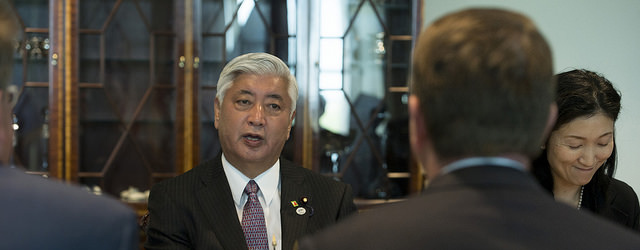Japanese Defense Minister Gen Nakatani proposed a “Shangri-La Dialogue Initiative” (SDI) at this year’s Shangri-La Dialogue in Singapore. To build foundation for deeper security collaboration with regional partners, Nakatani proposed crisis management though the promotion of common rules and law in the maritime and air domains, maritime and air security through the enhancement of regional maritime domain awareness (MDA), and confidence-building through the improvement of regional disaster response capability.
Nakatani proposed the SDI after explaining the new U.S.-Japan Defense Guidelines and the on-going national security legislation reform. Japan has played an important role in South China Sea issues, particularly in terms of capacity building. As its role is expected to expand under the new Guidelines and legislation, the SDI indicates how Japan will expand its engagement in the troubled waters of the South China Sea.
The SDI is a follow-up of the “three principles for the rule of law,” proposed by Prime Minister Shinzo Abe at the 2014 Shangri-La Dialogue. In view of rising territorial and maritime tensions in the Asia-Pacific region, Abe called for countries to make and clarify claims based on international law, to avoid using force or coercion in resolving conflicts, and to seek to settle disputes by peaceful means. Putting these three principles of the rule of law into practice is essential for the stability of the Indo-Pacific region. In reality, however, there is no consensus on the legal basis for maritime boundaries in postwar Asia. The national sea boundaries in Asia are based on the 1951 San Francisco Peace Treaty signed between Japan and 48 other countries, but those countries not party to this treaty are not bound by its provisions.
There is no universal interpretation of the law of sea, either. Interpretations of the law of the sea vary by country, for example, on the extent to which coastal countries can restrict the innocent passage of foreign vessels through territorial waters and on whether coastal countries possess jurisdiction in terms of security within exclusive economic zones. These disagreements have at times sparked diplomatic confrontation and precarious encounters between military forces.
There is, therefore, a pressing need for crisis management, MDA, and confidence-building to maintain good order at sea. This is why the SDI calls for those measures. A crisis management mechanism must be established in the region to avoid miscalculation and control escalation. Japan and China are about to agree on maritime/air communication mechanism between defense authorities. The next step is to establish a code of conduct in the maritime and air domains. Similar efforts are being made between the United States and China, and between ASEAN and China. These efforts are designed to manage crises through the application of existing international law (UNCLOS) and international rules (such as COLREGS and CUES). If they prove successful, they will contribute substantially to establishing the rule of law in Asian seas.
Crisis management at sea is difficult without knowing what is going on over the horizon. The missing of MH370 indicates the lack of regional maritime situational awareness. The enhancement of regional MDA is therefore urgent. In this regard, Japan will continue to help build capacity of regional partners. Japan has thus far limited its maritime surveillance to surrounding sea areas but, it will be also able to conduct maritime surveillance in the South China Sea and elsewhere to develop more accurate maritime situational awareness in Asia.
South China Sea dangers are compounded by a lack of regional trust. Regional countries need to build trust by building confidence first. As the region often suffers from massive disasters, disaster relief cooperation provides lots of opportunities for goodwill exchanges, capacity building, combined trainings, and saving lives. Disaster relief cooperation is also good in terms of clearing the suspicion China and some ASEAN countries may have about Japan’s new security policy and proactive engagement in the South China Sea disputes.
China’s rapid and massive land reclamation in the Spratly Islands, coupled with more frequent submarine operations, is intensifying the tension in the South China Sea. As the United States prepares operational assertions within 12 nautical miles from Chinese artificial islands, chances for military confrontation and escalation are becoming higher. Under the new U.S.-Japan Defense Guidelines and security legislation, Japan may be involved in a South China Sea contingency either through logistical support for U.S. military or even collective defense. Under such a circumstance, the SDI is not rhetoric but a strategic objective for Japan.
